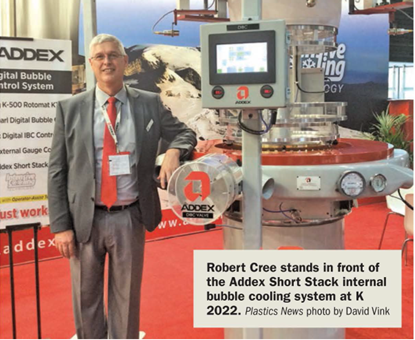By David Vink
Plastics News Correspondent
Newark, N.Y.-based blown film equipment supplier Addex Inc. came to K 2022 with a new Short Stack version of its intensive cooling system. The new equipment promises a typical 25 percent increase in output compared with the company’s first “Down-on-the-Die” intensive cooling system, which was first introduced at K 2016 and had already achieved 10-15 percent improved output over the conventional dual-flow air rings of that time.
Addex President Robert Cree recounted to Plastics News at K 2022 that the company he founded in 1989 with Rick von Kraus after working in Mobil Chemical’s research center in the 1980s, was originally involved with full blown film extrusion lines before Cree decided to specialize on cooling. He described how the latest system cools already from the die “up to where the thickness is measured.”
The productivity gains with the system fit in well with present strong interest in saving resources.
“To be a good citizen today, you have to be green. I am glad to see the industry has stepped up and is challenging itself, which is fabulous, an excellent approach,” Cree said.
One key issue, however, is to get hold of experienced people to run blown film lines. This means operators are also often “green,” he chuckled, and suggesting some fresh thinking is required.
It is therefore beneficial that all Addex equipment comes with an operator-assist system, symbolized by the letter Å, which simplifies operation.
“It means you just have to push one button and it does the rest,” Cree said. Bearing in mind there are many blown film lines in operation, Cree said not everyone can afford a completely new modern line. This is one reason why Addex focuses on supplying its equipment as retrofits for existing lines.
And there is a real need, Cree said, “as the newest, therefore less experienced operators tend to be applied to old existing lines, in a belief they can’t do much harm, while experienced operators are trusted to be allocated to expensive new lines.”
The Addex system is accordingly simple to operate, due to the fact its height is not adjustable and an additional three points of bubble stabilization.
Cree showed how the system is started up and the bubble cage begins to move. Four ultrasonic sensors are fitted to the cage and move with it, and there are another four mounted on the top of the cage. Should the bubble become too big, the sensors detect this instability and can get the cage to respond and restabilize before the bubble hangs up or becomes damaged. This is achieved by changing the relative speed of the blowers via digital internal bubble valve to ensure correct vertical and horizontal positioning for the correct bubble diameter via step motors.
A key feature of the Short Stack system is the aerodynamic approach, whereby additional high-velocity air streams have been added to the traditional commonly used single high-velocity main lip air stream. This improves cooling but also aids bubble stability by helping to hold the bubble better in place.
And films that are difficult to process can be run at higher speeds, as cooling starts just above the die lip. Increased bubble stability makes it easier to process lower melt strength materials.
Plastics News photo by David Vink

